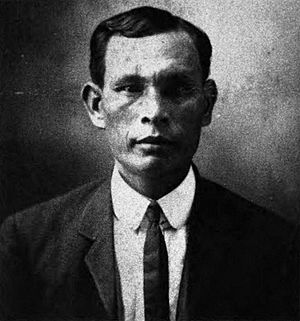Chang Apana facts for kids
Quick facts for kids
Chang Apana
|
|
|---|---|

Chang Apana (born Ah Ping Chang)
|
|
| Born | December 26, 1871 Waipio, Oahu, Hawaiian Kingdom
|
| Died | December 8, 1933 (aged 61) Honolulu, Oahu, Territory of Hawaii
|
| Police career | |
| Department | Honolulu Police Department |
| Years of service | 34 |
| Rank | Detective |
Chang Apana (born December 26, 1871 – died December 8, 1933) was a famous Chinese-Hawaiian police officer. He worked for the Honolulu Police Department as an officer and later as a detective. Chang Apana is well-known because he inspired the popular fictional detective, Charlie Chan.
Contents
Discovering Chang Apana's Early Life
Chang Apana was born as Chang Ah Ping on December 26, 1871. His birthplace was Waipio, on the island of Oahu, Hawaii. The name Apana is a Hawaiian way of saying his Chinese name, Ah Ping. When he was three years old, his family moved back to China.
Chang returned to Hawaii at age 10. He lived with his uncle in Waipio. As an adult, Chang could speak several languages. He was fluent in Hawaiian, Hawaiian Pidgin, and Cantonese. He never learned to read, so his family helped him with newspapers.
Becoming a Paniolo and Joining the Police
In his younger years, Chang worked as a paniolo. A paniolo is a Hawaiian cowboy. He started this job in 1891. This is when he began to regularly carry a bullwhip.
Three years later, Chang started working for the Hawaii Humane Society. At that time, the Humane Society was part of the police department. The Humane Society was started by Helen Kinau Wilder. She owned the horses Chang had worked with.
Chang Apana's Police Career
In 1898, Chang joined the Honolulu Police Department. He was assigned to patrol the Chinatown area. Chang was very successful at solving cases. This was partly because he spoke many languages. He also had a wide network of people who gave him information. His detective style was smart and careful.
Many interesting stories are told about Chang's police work.
- He helped people with certain illnesses get the care they needed.
- Once, he was attacked by a person with a sickle. This left a scar above his right eye.
- Another story says he warned about illegal goods. This happened after he was run over by a horse and buggy.
- One night, Chang arrested 40 gamblers by himself. He used only his bullwhip. He then marched them all back to the police station.
How Chang Apana Inspired Charlie Chan
The author Earl Derr Biggers visited Hawaii in 1920. This trip gave him the idea to write his novel House Without a Key. In 1924, Biggers was reading Honolulu newspapers. He learned about Chang Apana's detective work.
Biggers then created a new character for his book. This character was based on Chang. The character became very popular. Biggers made him a bigger part of his later novels.
Meeting the Fictional Charlie Chan
Chang Apana met actor Warner Oland. Oland played Charlie Chan in movies. They met when the movie The Black Camel was filmed in Hawaii. This happened in 1931.
When Biggers met Chang in 1928, people already called the real detective "Charlie Chan." Chang enjoyed watching the movies about his fictional counterpart. Biggers wrote five more novels. In 1932, he publicly said that Chang was the inspiration for his character. He wrote this in a letter to the Honolulu Advertiser.
However, Biggers's widow later said something different. She stated that Charlie Chan was actually based on Biggers himself. She said they were similar in body shape and personality. Chang, on the other hand, was small and quick to get angry. He also worked on very few murder cases.
Retirement and Death
Chang Apana worked for 34 years. He retired in May 1932 as a detective. This was after he was hurt in a car accident. For a short time, he worked as a watchman. He worked at the Hawaiian Trust building.
On December 2, 1933, Chang went to Queen's Hospital. He had been sick for a month. On December 7, his leg was removed. He passed away the next day, on December 8, 1933. Chang is buried in the Manoa Chinese cemetery in Honolulu.
Chang Apana's Influence on Stories
Chang Apana's police career inspired other fictional works. These were not just the Charlie Chan stories.
- Max Allan Collins wrote a novel in 1996 called Damned in Paradise. This book tells a fictional story about the famous Massie case. Collins included fictional versions of real people, like Chang Apana. Chang was a detective during the time of the Massie case.
- Usagi Yojimbo is a comic book series by Stan Sakai. It is set in 17th century Japan. The characters are animal-like. A character named Inspector Ishida appears sometimes. He is partly based on Chang Apana. Inspector Ishida is a tougher character than the calm Charlie Chan.
- In a 2011 comic story, Chang Apana was mentioned in the Dick Tracy newspaper strip. A police officer named Haku Kou is a friend of Dick Tracy. Kou explains that he learned to use a blacksnake whip because he admired Chang Apana.
- Chang was also featured in an episode of the TV show Hawaii Five-0. It was the seventh episode of the ninth season. The episode was called "Pua A'e La Ka Uwahi O Ka Moe". It showed some of Chang's stories and his success in solving cases.

